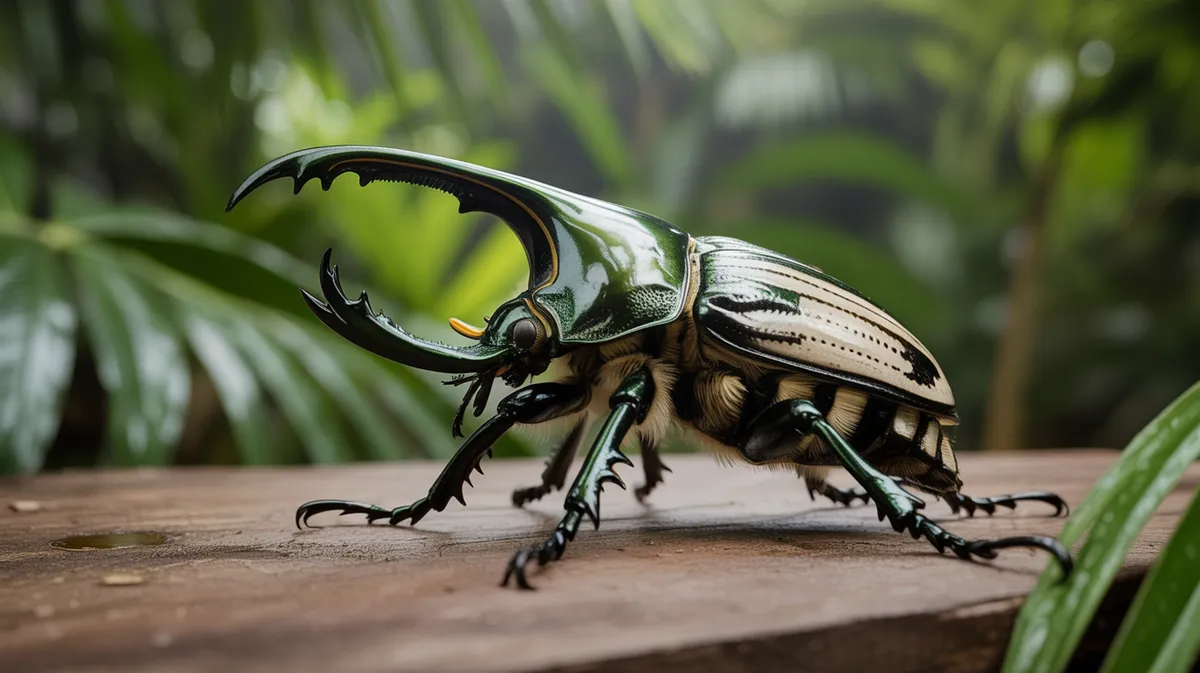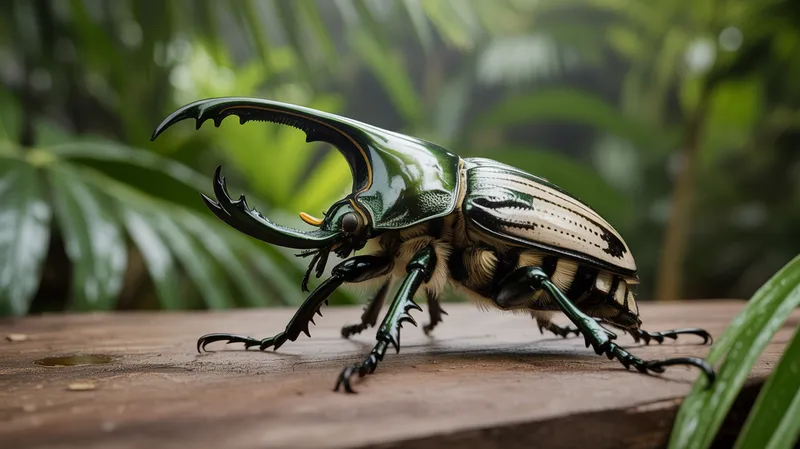
Giant Goliath Beetle
Goliathus goliatus

Meet the Giant Goliath Beetle
The Giant Goliath Beetle is one of the largest and heaviest insects in the world, belonging to the scarab beetle family. Native to the tropical rainforests of Central and West Africa, these beetles are renowned for their impressive size, striking coloration, and robust build. Adult males often display distinctive horn-like protrusions used in combat over mates, while females are generally larger but lack these horns. Their larvae can grow even heavier than the adults, feeding voraciously on decaying wood and plant matter.
Classification
Invertebrate
Habitat
Tropical rainforest
Diet
Omnivore
Lifespan
6 months to 1 year (adults)
Conservation
Least Concern
Weight
80–100 grams (adults), larvae up to 100 grams
📖Fascinating Facts
Heavyweight Champion
The Goliath Beetle is one of the heaviest insects in the world, with larvae sometimes exceeding 100 grams in weight.
Rainforest Resident
These beetles are found in tropical rainforests of Central and West Africa, where they play a role in decomposing plant matter.
Horned Males
Male Giant Goliath Beetles have prominent Y-shaped horns used in battles for territory and mates.
📋Detailed Description
The Giant Goliath Beetle (Goliathus goliatus) is among the largest and most massive insects on Earth, with adult males reaching lengths of 60–110 mm and females slightly shorter but often bulkier. Males can weigh up to 100 grams in the larval stage, with adults typically weighing 50–80 grams. Their exoskeleton is robust and exhibits striking coloration, ranging from white to dark brown with bold black markings, which may serve as camouflage among tree bark and leaves. The male's prominent Y-shaped cephalic horn is used in ritualized combat to dislodge rivals during mating competitions, while females lack this structure but possess a broader body for egg production. Goliath beetles have powerful, spade-like forelegs adapted for digging and climbing. Their wings are protected by thick elytra, and they are capable of strong, albeit clumsy, flight. The species is mainly diurnal, with adults emerging during the rainy season when food is abundant. Larvae develop in decaying wood, feeding on a protein-rich diet, which is unusual among beetles and contributes to their exceptional size. Adults feed primarily on tree sap, fruit, and occasionally pollen, using their brush-like mouthparts. Their life cycle, from egg to adult, can span several months to over a year, depending on environmental conditions.
💡 Did you know?
The larvae of the Giant Goliath Beetle can consume more food and weigh more than the adult beetles themselves.
🔬Research & Sources
🎭Behavior & Social Structure
Goliathus goliatus exhibits solitary behavior outside of the breeding season, with adults being most active during the day (diurnal). They are strong climbers, often found on tree trunks and branches where they feed on sap flows and overripe fruit. Males are territorial and will engage in aggressive contests using their horns to flip or push rivals away from feeding or mating sites. Feeding involves using their brush-tipped maxillae to lap up liquids, and they are attracted to fermenting fruit due to the high sugar content. Larvae are voracious feeders, consuming large amounts of decaying wood and organic debris, which supports their rapid growth. Adults are generally sedentary except when searching for mates or new feeding sites. There is little evidence of social cooperation, and individuals are usually encountered alone.
👶Reproduction & Life Cycle
Breeding occurs at the onset of the rainy season, which triggers adult emergence and mating activity. Males compete for access to females through physical contests. After mating, females lay eggs in moist, decaying wood or leaf litter. The eggs hatch after 10–20 days, and the larvae undergo three instars over 4–6 months, depending on temperature and food availability. Larvae are notable for their protein-rich diet, which is atypical for scarab beetles and essential for reaching their large size. Pupation occurs in a subterranean chamber constructed by the larva, lasting 1–2 months. There is no parental care after oviposition. Adults typically live for 3–6 months, with their reproductive activity concentrated in a single season.
🛡️Adaptations & Survival
Goliathus goliatus has evolved several remarkable adaptations. The male's cephalic horn is a specialized structure for intraspecific combat, increasing reproductive success. Their large size and heavy exoskeleton provide protection against many predators. The larvae's ability to digest protein-rich material enables rapid growth and supports their extraordinary mass. Adults possess strong, hooked tarsi for climbing and gripping bark, while their cryptic coloration helps them blend into their arboreal environment. Their powerful flight muscles, although supporting only short flights, allow dispersal between feeding and breeding sites. The beetle's digestive system is adapted for both plant and animal matter, reflecting its omnivorous diet.
📚Research Sources
🎨Cultural Significance
Goliath beetles have fascinated humans for centuries due to their immense size and striking appearance. In some West African cultures, they are featured in folklore as symbols of strength and endurance. Their impressive exoskeletons are collected and displayed in museums and private collections worldwide. In the pet trade, Goliathus goliatus larvae are sometimes reared for educational purposes or as exotic pets. There are no significant traditional medicinal or culinary uses documented for this species.
🔬Recent Research & Discoveries
Recent research has focused on the larval nutritional requirements and the unique protein-based diet that enables their exceptional growth, with implications for understanding insect physiology and metabolism. Studies on horn morphology and combat behavior have provided insights into sexual selection and evolutionary arms races among scarab beetles. Genetic analyses are ongoing to clarify relationships within the Goliathus genus and to assess population structure across their range. Conservation studies are monitoring the impact of habitat loss and the international insect trade on wild populations. The beetle's robust exoskeleton and flight mechanics have also inspired biomimetic research in materials science and robotics.
🎥Wildlife Videos

Stag Beetle Throws Girlfriend Out Of Tree | Life | BBC Earth
It's not easy finding a girlfriend these days, and it's no different for this stag beetle. He doesn't seem too concerned about ...
BBC Earth

"Top 10 Most Fascinating Beetles on Earth | Nature’s Tiny Giants"| #animals #beetlesgelpolish
Top 10 Most Fascinating Beetles on Earth | Nature's Tiny Giants** Welcome to the wild world of beetles! In this video, we ...
Magic Morals Stories

Bug Giants: The Largest Insects You Might Encounter!
Some insects grow bigger than you ever imagined! From massive beetles to giant wasps, here are the 10 largest insects on ...
Journey Journals

THE LARGEST INSECTS IN THE WORLD
If your life depended on naming the largest insects in the world would you be able to list them? Of course, dragonflies would be ...
Viral Now

MARVELS of the MINIATURE GIANTS Exploring EARTH'S LARGEST INSECTS and Their ECOLOGICAL SECRETS
00:00:00 A World of Giants 00:01:07 The Titans of the Undergrowth 00:02:25 The Goliath Beetle 00:03:32 A Miniature Terror ...
CELEBRATINGNATUREGROUP

Top 5 Largest Insects in the World
Get ready to be amazed (and maybe a little creeped out!) by the top 5 largest insects in the world! From massive beetles to ...
Life in the Wild - Animals and Nature Channel
🌍Habitat Information
The Giant Goliath Beetle typically inhabits Tropical rainforest environments. Giant Goliath Beetles have adapted to their environments with specialized features and behaviors.
Primary Habitat:
Tropical rainforest
More detailed habitat information will be available soon.
🛡️Conservation Status
The Giant Goliath Beetle is currently classified as Least Concern. Conservation efforts are crucial for preserving this species for future generations.
Common Threats:
- 🏠Habitat loss and fragmentation
- 🌡️Climate change impacts
- 🎯Hunting and poaching
- 🏭Human-wildlife conflict
⚠️Threats & Conservation Challenges
Currently classified as Least Concern, Goliathus goliatus faces localized threats from habitat loss due to deforestation and conversion of rainforest to agriculture. Over-collection for the pet trade and as specimens for collectors can impact local populations, especially in accessible areas. Climate change may alter the timing and abundance of fruiting trees, affecting adult feeding and breeding. However, the species remains widespread and resilient in undisturbed forest habitats. Population trends are stable overall, but continued habitat fragmentation could pose future risks.
🔬Scientific Classification
Scientific Name
Goliathus goliatus
Classification Hierarchy
🔍 About Taxonomic Classification
Taxonomic classification is a hierarchical system used by scientists to classify and organize living organisms based on shared characteristics and evolutionary relationships.
The system moves from broad categories (Kingdom) to increasingly specific ones, with each animal's scientific name typically consisting of its Genus and species.
📝Community Notes
Share your observations and insights about the Giant Goliath Beetle with our community of wildlife enthusiasts.
Join Our Community
Sign in to share your observations and connect with fellow wildlife enthusiasts.
Sign In to ContributeNo community notes yet
Be the first to share your observations about the Giant Goliath Beetle!
Explore Giant Goliath Beetle
Select a tab above to learn more about this amazing animal.
📸Photo Gallery
No photos available for this animal yet.
🌟Discover More Wildlife
Continue your journey of discovery with more fascinating animals from our database
